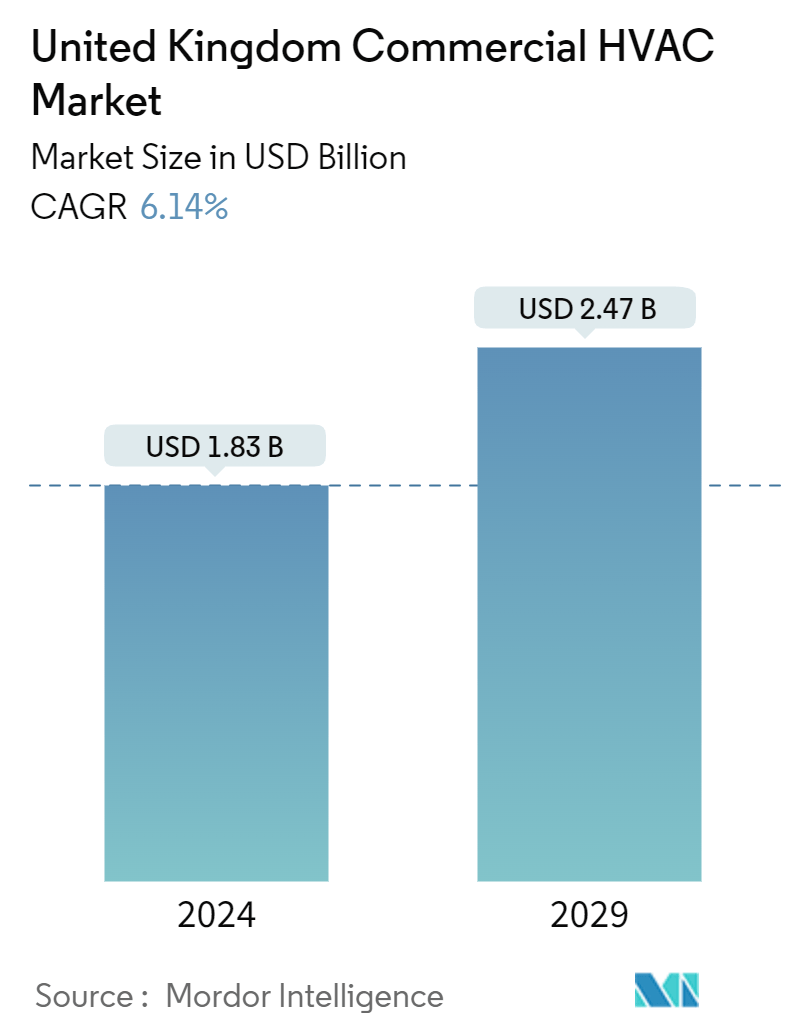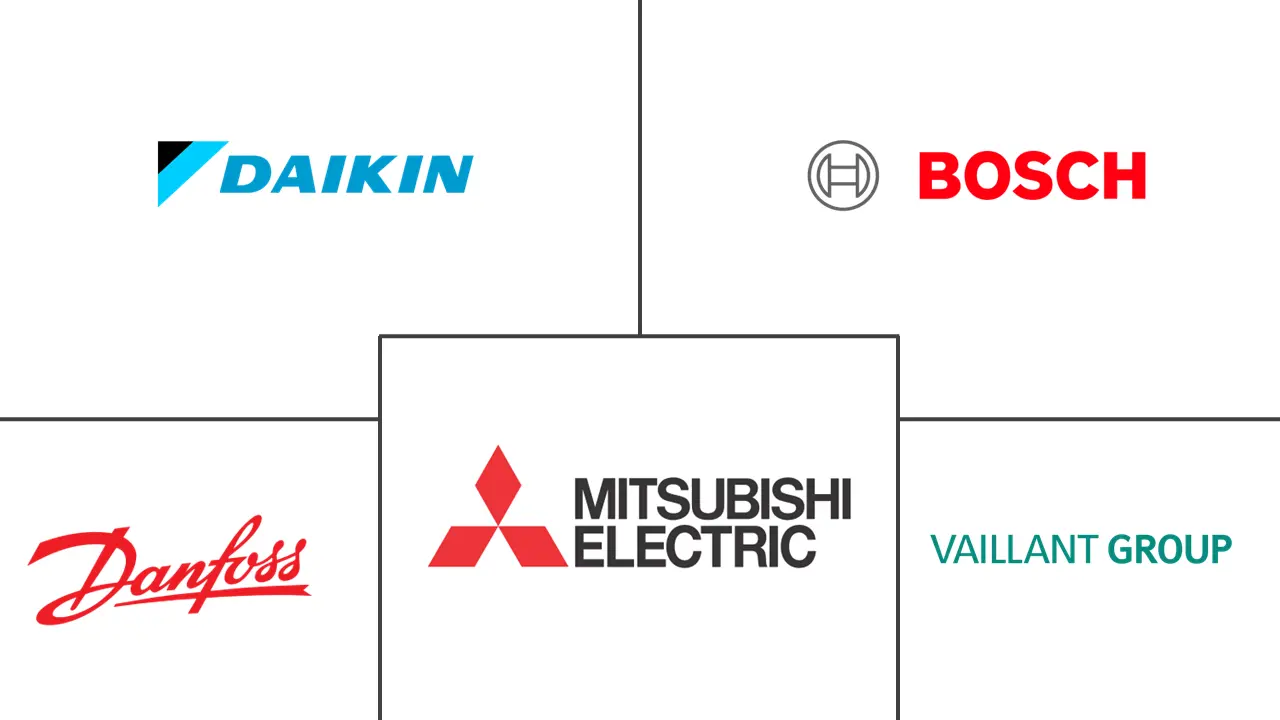Market Size of United Kingdom Commercial HVAC Industry

| Study Period | 2019 - 2029 |
| Base Year For Estimation | 2023 |
| Market Size (2024) | USD 1.83 Billion |
| Market Size (2029) | USD 2.47 Billion |
| CAGR (2024 - 2029) | 6.14 % |
| Market Concentration | Medium |
Major Players
*Disclaimer: Major Players sorted in no particular order |
United Kingdom Commercial HVAC Market Analysis
The United Kingdom Commercial HVAC Market size is estimated at USD 1.83 billion in 2024, and is expected to reach USD 2.47 billion by 2029, growing at a CAGR of 6.14% during the forecast period (2024-2029).
- The United Kingdom is witnessing a surge in demand for HVAC equipment in the commercial sector, primarily fueled by the increasing embrace of air conditioning systems. This uptick can be attributed to a confluence of factors: climate change, urbanization, evolving lifestyles, and technological advancements. Moreover, the market is further bolstered by enhanced commercial space construction activities, governmental support for green building endeavors, and the swift pace of urbanization.
- Governments are looking forward to introducing stringent regulations, thus mandating the incorporation of heat pumps and positively impacting the market studied. For instance, the European Union also announced the installation of 60 million more heat pumps by 2030, in line with the EU targets, which would reduce the gas demand in buildings by 40% by 2030 compared to 2022 and decrease its energy import bill by EUR 60 billion (USD 65.31 billion).
- The flourishing construction industry has unlocked substantial business opportunities for air conditioners installed for heating and cooling purposes in commercial facilities such as shopping centers, commercial complexes, parking units, and hotels.
- Landsec, a property developer, completed the Forge Bankside in January 2023. This commercial office development consists of two newly constructed 9-story buildings, offering a combined internal space of approximately 140,000 sq. ft. Notably, the Forge is the first commercial office project to comply with the UK Green Building Council's (UKGBC) net-zero carbon buildings framework. Governmental policies influence the HVAC market in the UK and find support in the European Union's ambitious target to slash carbon emissions significantly by 2050.
- The HVAC Industry is shifting towards advanced technologies due to a high level of AI and IoT integrations. Further, Artificial Intelligence (AI) is also a noteworthy trend in HVAC Systems. AI-powered heating and cooling technologies can automatically manage factors such as indoor temperature, set temperatures, outdoor temperature, and others. The leading HVAC system providers are incorporating the latest advanced technologies, which will boost the market growth in the coming years.
- Global manufacturers are focusing on energy efficiency as one of their key concerns. Many players, such as Daikin, Carrier, Robert Bosch Gmbh, Danfoss A/s, Mitsubishi Electric Europe Bv, and Lennox International Inc., have already started launching energy-efficient HVAC products, and hence, they have become price setters in the market. Thus, comparatively smaller players lack the financial capacity to match the level of technological innovations incorporated in these products, and they have to sell their products at a lower price point. Growing competition will limit the growth in coming years.
- Moreover, the ongoing war between Russia and Ukraine has brought instability in a political and economic situation that results in a decline in consumer purchasing power within the region. Military conflicts could disrupt the UK's trade with Japan, South Korea, and Taiwan, all of which might find themselves entangled in potential Sino-U.S. hostilities. Several consumer goods could face shortages, and UK manufacturing might struggle due to a lack of essential supplies. Severe shortages of manufactured goods and intermediate inputs could trigger a significant inflation surge in the UK and globally.
United Kingdom Commercial HVAC Industry Segmentation
Heating, ventilation, and air conditioning (HVAC) are technologies that regulate the temperature, humidity, and air purity within enclosed spaces. HVAC systems' primary aim is to ensure thermal comfort and acceptable indoor air quality.
The study tracks the revenue accrued through the sale of Commercial HVAC by various players in the United Kingdom. The study also tracks the key market parameters, underlying growth influencers, and major vendors operating in the industry, which supports the market estimations and growth rates over the forecast period. The study further analyses the overall impact of COVID-19 aftereffects and other macroeconomic factors on the market. The report’s scope encompasses market sizing and forecasts for the various market segments.
The United Kingdom commercial HVAC market is segmented by type of component (HVAC equipment [heating equipment, air conditioning /ventilation equipment], HVAC services) and by end-user industry (hospitality, commercial buildings, public buildings, and others). The market sizes and forecasts are provided regarding value (USD) for all the above segments.
| By Type of Component | ||||
| ||||
| HVAC Services |
| By End User Industry | |
| Hospitality | |
| Commercial Buildings | |
| Public Buildings | |
| Others |
United Kingdom Commercial HVAC Market Size Summary
The United Kingdom commercial HVAC market is experiencing robust growth, driven by an increasing demand for air conditioning systems and advanced heating solutions. This demand is fueled by factors such as climate change, urbanization, and technological advancements, alongside a flourishing construction industry that supports the installation of HVAC systems in commercial spaces like shopping centers, hotels, and office complexes. Government initiatives promoting green building practices and the adoption of heat pumps are further propelling market expansion. The market is characterized by a shift towards energy-efficient and sustainable solutions, with significant investments in AI and IoT technologies enhancing system capabilities. However, geopolitical tensions and economic uncertainties pose challenges, potentially impacting consumer purchasing power and supply chains.
The market landscape is competitive, with major players like Daikin, Mitsubishi Electric, and Honeywell leading the charge in innovation and product development. These companies are focusing on energy efficiency and sustainability, launching advanced HVAC products that cater to the evolving needs of commercial properties. The adoption of ductless mini-split air conditioners and heat pumps is on the rise, offering flexible and efficient solutions for heating and cooling in large commercial buildings. Despite the challenges posed by global events, the UK commercial HVAC market is poised for continued growth, supported by ongoing construction activities and a strong emphasis on decarbonization and energy efficiency.
United Kingdom Commercial HVAC Market Size - Table of Contents
-
1. MARKET INSIGHTS
-
1.1 Market Overview
-
1.2 Industry Attractiveness - Porter's Five Forces Analysis
-
1.2.1 Bargaining Power of Suppliers
-
1.2.2 Bargaining Power of Consumers
-
1.2.3 Threat of New Entrants
-
1.2.4 Threat of Substitute Products
-
1.2.5 Intensity of Competitive Rivalry
-
-
1.3 Industry Value Chain Analysis
-
1.4 Impact of COVID-19 Aftereffects and Other Macroeconomic Factors on the Market
-
-
2. MARKET SEGMENTATION
-
2.1 By Type of Component
-
2.1.1 HVAC Equipment
-
2.1.1.1 Heating Equipment
-
2.1.1.2 Air Conditioning /Ventillation Equipment
-
-
2.1.2 HVAC Services
-
-
2.2 By End User Industry
-
2.2.1 Hospitality
-
2.2.2 Commercial Buildings
-
2.2.3 Public Buildings
-
2.2.4 Others
-
-
United Kingdom Commercial HVAC Market Size FAQs
How big is the United Kingdom Commercial HVAC Market?
The United Kingdom Commercial HVAC Market size is expected to reach USD 1.83 billion in 2024 and grow at a CAGR of 6.14% to reach USD 2.47 billion by 2029.
What is the current United Kingdom Commercial HVAC Market size?
In 2024, the United Kingdom Commercial HVAC Market size is expected to reach USD 1.83 billion.

